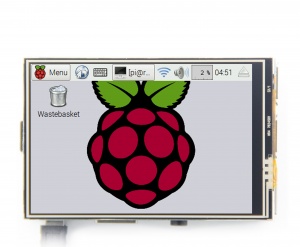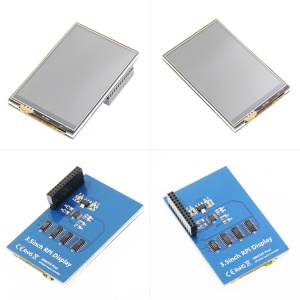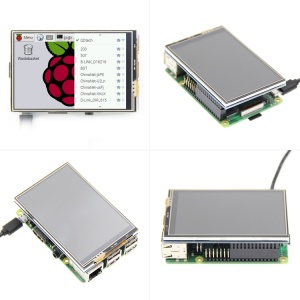More actions
No edit summary |
|||
| (105 intermediate revisions by 3 users not shown) | |||
| Line 5: | Line 5: | ||
en=http://www.lcdwiki.com/3.5inch_RPi_Display | en=http://www.lcdwiki.com/3.5inch_RPi_Display | ||
}} | }} | ||
== Features == | |||
== <font color="blue">Product Video</font> == | |||
{{#ev:youtube|5DAn_5-1Jg4}} | |||
*[http://www.lcdwiki.com/Video_Presentation Related Video] | |||
== <font color="blue">Product Pictures</font>== | |||
[[File:MPI3501-100-1.jpg|300px]] | |||
[[File:MPI3501-001.jpg|300px]] | |||
[[File:MPI3501-002.jpg|300px]] | |||
==<font color="blue"> Features </font>== | |||
* 320×480 resolution | * 320×480 resolution | ||
* Resistive touch control | * Resistive touch control | ||
* Supports any revision of Raspberry Pi (directly-pluggable) | * Supports any revision of Raspberry Pi (directly-pluggable) | ||
* Compatible with Raspberry Pi A, B, A+, B+, 2B, 3B, 3B+versions | * Compatible with Raspberry Pi A, B, A+, B+, 2B, 3B, 3B+,4B versions | ||
* Drivers provided (works with your own Raspbian/Ubuntu directly) | * Drivers provided (works with your own Raspbian/Ubuntu directly) | ||
* Size perfectly fits the Pi | * Size perfectly fits the Pi | ||
| Line 16: | Line 27: | ||
* Supports Raspbian system, ubuntu system ,kali Linux system | * Supports Raspbian system, ubuntu system ,kali Linux system | ||
== Key Parameters == | == <font color="blue">Key Parameters </font>== | ||
{| class="wikitable" border="1" style="width: 50%; background-color: white;" | {| class="wikitable" border="1" style="width: 50%; background-color: white;" | ||
|SKU | |SKU | ||
| Line 25: | Line 36: | ||
|- | |- | ||
|LCD Interface | |LCD Interface | ||
|SPI | |SPI(Fmax:32MHz) | ||
|- | |- | ||
|Touch Screen Type | |Touch Screen Type | ||
| Line 35: | Line 46: | ||
|Colors | |Colors | ||
|65536 | |65536 | ||
|- | |||
|Driver IC | |||
|ILI9486 | |||
|- | |- | ||
|Backlight | |Backlight | ||
| Line 40: | Line 54: | ||
|- | |- | ||
|Resolution | |Resolution | ||
|320* | |320*480 (Pixel) | ||
|- | |- | ||
| | |Backlight Current | ||
| | |120ma | ||
|- | |- | ||
| | |Power Dissipation | ||
| | |0.13A*5V | ||
|- | |- | ||
|Operating Temp. (℃) | |Operating Temp. (℃) | ||
| | | -20~60 | ||
|- | |- | ||
|Active Area | |||
|48.96x73.44(mm) | |||
|- | |- | ||
| | |Product Size | ||
| | |85.42*55.60(mm) | ||
|- | |- | ||
| | |Package Size | ||
| | |118*72*34 (mm) | ||
|- | |- | ||
| | |Rough Weight(Package containing) | ||
| | |75 (g) | ||
| | |} | ||
== <font color="blue">Interface </font>== | |||
{| class="wikitable" border="1" style="width: 50%; background-color: white;" | |||
|+ | |||
!PIN NO. | |||
!SYMBOL | |||
!DESCRIPTION | |||
|- | |- | ||
| | |1, 17 | ||
| | |3.3V | ||
| | |Power positive (3.3V power input) | ||
|- | |- | ||
| | |2, 4 | ||
| | |5V | ||
| | |Power positive (5V power input) | ||
|- | |- | ||
| 12 | |3, 5, 7, 8, 10, 12, 13, 15, 16 | ||
| | |NC | ||
| | |NC | ||
|- | |- | ||
| | |6, 9, 14, 20, 25 | ||
| | |GND | ||
| | |Ground | ||
|- | |- | ||
| | |11 | ||
| | |TP_IRQ | ||
| | |Touch Panel interrupt, low level while the Touch Panel detects touching | ||
|- | |- | ||
| | |18 | ||
| | |LCD_RS | ||
| | |Instruction/Data Register selection | ||
|- | |- | ||
| | |19 | ||
| | |LCD_SI / TP_SI | ||
| | |SPI data input of LCD/Touch Panel | ||
|- | |- | ||
| | |21 | ||
| | |TP_SO | ||
| SPI data | |SPI data output of Touch Panel | ||
|- | |- | ||
| | |22 | ||
| | |RST | ||
| | |Reset | ||
|- | |- | ||
| 23 | |23 | ||
| LCD_SCK / TP_SCK | |LCD_SCK / TP_SCK | ||
| SPI clock of LCD/Touch Panel | |SPI clock of LCD/Touch Panel | ||
|- | |- | ||
| 24 | |24 | ||
| LCD_CS | |LCD_CS | ||
| LCD chip selection, low active | |LCD chip selection, low active | ||
|- | |- | ||
| 26 | |26 | ||
| TP_CS | |TP_CS | ||
| Touch Panel chip selection, low active | |Touch Panel chip selection, low active | ||
|} | |} | ||
==<font color="blue">Driver Installation </font>== | |||
This LCD Module need install driver first. | |||
===Step 1:Download the Raspbian IMG=== | |||
https://www.raspberrypi.com/software/operating-systems/ | |||
===Step 2: Burn the system image=== | ===Step 2: Burn the system image=== | ||
If you don't know how to do that,you can refer to the [https://www.raspberrypi.org/documentation/installation/installing-images/README.md Raspberry Pi office tutorial] | If you don't know how to do that,you can refer to the [https://www.raspberrypi.org/documentation/installation/installing-images/README.md Raspberry Pi office tutorial] | ||
===Step 3: Open terminal and | ===Step 3: Open terminal(SSH) and install the driver on RaspberryPi=== | ||
(tested on RaspberryPi 3B+,3B,2B,2B+,1B,ZERO) | |||
'''Run:'''<br> | '''Run:'''<br> | ||
{{code|1= | {{code|1= | ||
| Line 141: | Line 156: | ||
Wait A Few Minutes, when the system reboot ok, you can see that.<br> | Wait A Few Minutes, when the system reboot ok, you can see that.<br> | ||
==Touch screen calibration== | ==<font color="blue">Touch screen calibration </font>== | ||
*This LCD can be calibrated using a program called xinput_calibrator | *This LCD can be calibrated using a program called xinput_calibrator | ||
| Line 149: | Line 164: | ||
sudo dpkg -i -B xinput-calibrator_0.7.5-1_armhf.deb | sudo dpkg -i -B xinput-calibrator_0.7.5-1_armhf.deb | ||
}} | }} | ||
*Click the '''Men''' button on the task bar, choose '''Preference''' -> '''Calibrate Touchscreen'''. | *Click the '''Men''' button on the task bar, choose '''Preference''' -> '''Calibrate Touchscreen'''. | ||
*Finish the touch calibration following the prompts. Maybe rebooting is required to make calibration active. | *Finish the touch calibration following the prompts. Maybe rebooting is required to make calibration active. | ||
| Line 155: | Line 171: | ||
/ect/X11/xorg.conf.d/99-calibration.conf | /ect/X11/xorg.conf.d/99-calibration.conf | ||
}} | }} | ||
*Save the touch parameters (may differ depending on LCD) to 99-calibration.conf, as shown in the picture: | *Save the touch parameters (may differ depending on LCD) to 99-calibration.conf, as shown in the picture: | ||
== | == <font color="blue">How to rotate the display direction</font> == | ||
*'''Step 1''',If the driver is not installed, execute the following command (Raspberry Pi needs to connected to the Internet): | |||
{{code| | |||
sudo rm -rf LCD-show | |||
git clone https://github.com/goodtft/LCD-show.git | |||
chmod -R 755 LCD-show | |||
cd LCD-show/ | |||
sudo ./LCD35-show }} | |||
After execution, the driver will be installed. <br/> | |||
*'''Step 2''',If the driver is already installed, execute the following command: | |||
{{code| | |||
cd LCD-show/ | |||
sudo ./rotate.sh 90}} | |||
After execution, the system will automatically restart, and the display screen will rotate 90 degrees to display and touch normally. <br/> | |||
( ' <font color="blue">90</font> ' can be changed to 0, 90, 180 and 270, respectively representing rotation angles of 0 degrees, 90 degrees, 180 degrees, 270 degrees) <br/> | |||
<font color="red">If the '''rotate.sh''' prompt cannot be found, use '''Step 1''' to install the latest drivers</font> | |||
==<font color="blue"> Download Resources</font>== | |||
* '''Document''' | |||
# [http://www.lcdwiki.com/res/PublicFile/How_to_install_the_LCD_driver_V1.2.pdf How_to_install_the_LCD_driver_V1.2] | |||
# [http://www.lcdwiki.com/res/PublicFile/How_to_install_matchbox-keyboard(En).pdf How_to_install_matchbox-keyboard] | |||
# [http://www.lcdwiki.com/res/Show_Direction_and_Touch/How_to_calibrate_the_resistance_touch_screen-V1.2.pdf How_to_calibrate_the_resistance_touch_screen-V1.2] | |||
# [http://www.lcdwiki.com/res/PublicFile/How_to_use_Raspberry_Pi(Download,Format,Burn,SSH,PuTTy)-V1.0.pdf How_to_use_Raspberry_Pi_Getting Star.pdf] | |||
# [http://www.lcdwiki.com/res/Show_Direction_and_Touch/How_to_change_display_direction-GPIO-Resistive_Touch-V1.2.pdf How_to_change_display_direction-GPIO-Resistive_Touch-V1.2] | |||
# [http://www.lcdwiki.com/res/MPI3501/MPI3501-3.5inch-RPi-Display-User-Manual-V1.0.pdf MPI3501-3.5inch-RPi-Display-User-Manual-V1.0] | |||
* '''Driver download''' | |||
:download::[http://www.lcdwiki.com/res/RaspDriver/LCD-show.tar.gz LCD-show.tar.gz] | |||
* '''Images download''' | |||
:If you have difficulty installing the driver, or if you still can't use the display properly after installing the driver, | |||
:Please Try our Configned images for tested. | |||
:Just need download and write the image into the TF card. DO NOT need any driver installation steps. | |||
{| class="wikitable" border="1" style="width: 90%; margin-left:1.5%;background-color: white;" | |||
!Image Name | |||
!Version | |||
!Support | |||
!Password | |||
! colspan="2" |Download | |||
|- | |||
| rowspan="2" |Raspbian | |||
| rowspan="2" |2024-03-15 | |||
| rowspan="2" |PI5/PI4/PI3B+/PI3/ | |||
PI2/PI1/ZERO/ZERO W | |||
| rowspan="2" |user:pi | |||
password:raspberry | |||
|[[File:Baiduyun.jpg|24px]]BaiduYun: | |||
|[https://pan.baidu.com/s/1U1NLaFAUUPnN-WoK0It05w MPI3501-3.5inch-2024-03-15-raspios-bookworm-armhf(support Pi4/5)] 提取码:n5zl | |||
|- | |||
|[[File:Mega-1.jpg|24px]]Mega: | |||
|[https://mega.nz/folder/ixQiTa7R#EM2uFGwMC8QSU6D4untoGA MPI3501-3.5inch-2022-04-04-raspios-bullseye-armhf.7z] | |||
|- | |||
| rowspan="2" |Ubuntu-MATE-32bit | |||
| rowspan="2" |22.04 | |||
| rowspan="2" |PI4,PI3B+,PI3,PI2 | |||
| rowspan="2" |user:pi | |||
password:raspberry | |||
|[[File:Baiduyun.jpg|24px]]BaiduYun: | |||
|[https://pan.baidu.com/s/1sr0UuQCqEbvjPio4RU9xEA MPI3501-3.5inch-ubuntu-mate-22.04-desktop-armhf+raspi.7z] 提取码:22e9 | |||
|- | |||
|[[File:Mega-1.jpg|24px]]Mega: | |||
|[https://mega.nz/folder/mhw2DCqK#qFiavXCAXOXMqOGjLXrtaw MPI3501-3.5inch-ubuntu-mate-22.04-desktop-armhf+raspi.7z] | |||
|- | |||
| rowspan="2" |Kali Linux RaspberryPi-32bit | |||
| rowspan="2" |2023.1 | |||
| rowspan="2" |PI4B,PI3B+,PI3,PI2 | |||
| rowspan="2" |user: kali | |||
password: kali | |||
|[[File:Baiduyun.jpg|24px]]BaiduYun: | |||
|[https://pan.baidu.com/s/13iNh1y0GNYRaZREuMgTXGQ MPI3501-3.5inch-kali-linux-2023.1] 提取码:vqt3 | |||
|- | |||
|[[File:Mega-1.jpg|24px]]Mega: | |||
|[https://mega.nz/folder/nlghUbSK#ZHPxHJCAi8gdoRG0uwC2og MPI3501-3.5inch-kali-linux-2022.1] | |||
|} | |||
* '''Software''' | |||
# [http://www.lcdwiki.com/res/software/Panasonic_SDFormatter.zip Panasonic SDFormatter] | |||
# [http://www.lcdwiki.com/res/software/Win32DiskImager.zip Win32DiskImager] | |||
# [http://www.lcdwiki.com/res/software/putty.zip PuTTY] | |||
[[#top|BACK TO TOP]] | [[#top|BACK TO TOP]] | ||
Latest revision as of 11:59, 11 June 2024
Product Video
Product Pictures
Features
- 320×480 resolution
- Resistive touch control
- Supports any revision of Raspberry Pi (directly-pluggable)
- Compatible with Raspberry Pi A, B, A+, B+, 2B, 3B, 3B+,4B versions
- Drivers provided (works with your own Raspbian/Ubuntu directly)
- Size perfectly fits the Pi
- High quality immersion gold surface plating
- Supports Raspbian system, ubuntu system ,kali Linux system
Key Parameters
| SKU | MPI3501 |
| LCD Type | TFT |
| LCD Interface | SPI(Fmax:32MHz) |
| Touch Screen Type | Resistive |
| Touch Screen Controller | XPT2046 |
| Colors | 65536 |
| Driver IC | ILI9486 |
| Backlight | LED |
| Resolution | 320*480 (Pixel) |
| Backlight Current | 120ma |
| Power Dissipation | 0.13A*5V |
| Operating Temp. (℃) | -20~60 |
| Active Area | 48.96x73.44(mm) |
| Product Size | 85.42*55.60(mm) |
| Package Size | 118*72*34 (mm) |
| Rough Weight(Package containing) | 75 (g) |
Interface
| PIN NO. | SYMBOL | DESCRIPTION |
|---|---|---|
| 1, 17 | 3.3V | Power positive (3.3V power input) |
| 2, 4 | 5V | Power positive (5V power input) |
| 3, 5, 7, 8, 10, 12, 13, 15, 16 | NC | NC |
| 6, 9, 14, 20, 25 | GND | Ground |
| 11 | TP_IRQ | Touch Panel interrupt, low level while the Touch Panel detects touching |
| 18 | LCD_RS | Instruction/Data Register selection |
| 19 | LCD_SI / TP_SI | SPI data input of LCD/Touch Panel |
| 21 | TP_SO | SPI data output of Touch Panel |
| 22 | RST | Reset |
| 23 | LCD_SCK / TP_SCK | SPI clock of LCD/Touch Panel |
| 24 | LCD_CS | LCD chip selection, low active |
| 26 | TP_CS | Touch Panel chip selection, low active |
Driver Installation
This LCD Module need install driver first.
Step 1:Download the Raspbian IMG
https://www.raspberrypi.com/software/operating-systems/
Step 2: Burn the system image
If you don't know how to do that,you can refer to the Raspberry Pi office tutorial
Step 3: Open terminal(SSH) and install the driver on RaspberryPi
(tested on RaspberryPi 3B+,3B,2B,2B+,1B,ZERO)
Run:
sudo rm -rf LCD-show git clone https://github.com/goodtft/LCD-show.git chmod -R 755 LCD-show cd LCD-show/ sudo ./LCD35-show
Wait A Few Minutes, when the system reboot ok, you can see that.
Touch screen calibration
- This LCD can be calibrated using a program called xinput_calibrator
- Install it with the commands:
cd LCD-show/
sudo dpkg -i -B xinput-calibrator_0.7.5-1_armhf.deb
- Click the Men button on the task bar, choose Preference -> Calibrate Touchscreen.
- Finish the touch calibration following the prompts. Maybe rebooting is required to make calibration active.
- You can create a 99-calibration.conf file to save the touch parameters (not necessary if file exists).
/ect/X11/xorg.conf.d/99-calibration.conf
- Save the touch parameters (may differ depending on LCD) to 99-calibration.conf, as shown in the picture:
How to rotate the display direction
- Step 1,If the driver is not installed, execute the following command (Raspberry Pi needs to connected to the Internet):
sudo rm -rf LCD-show git clone https://github.com/goodtft/LCD-show.git chmod -R 755 LCD-show cd LCD-show/ sudo ./LCD35-show
After execution, the driver will be installed.
- Step 2,If the driver is already installed, execute the following command:
cd LCD-show/ sudo ./rotate.sh 90
After execution, the system will automatically restart, and the display screen will rotate 90 degrees to display and touch normally.
( ' 90 ' can be changed to 0, 90, 180 and 270, respectively representing rotation angles of 0 degrees, 90 degrees, 180 degrees, 270 degrees)
If the rotate.sh prompt cannot be found, use Step 1 to install the latest drivers
Download Resources
- Document
- How_to_install_the_LCD_driver_V1.2
- How_to_install_matchbox-keyboard
- How_to_calibrate_the_resistance_touch_screen-V1.2
- How_to_use_Raspberry_Pi_Getting Star.pdf
- How_to_change_display_direction-GPIO-Resistive_Touch-V1.2
- MPI3501-3.5inch-RPi-Display-User-Manual-V1.0
- Driver download
- download::LCD-show.tar.gz
- Images download
- If you have difficulty installing the driver, or if you still can't use the display properly after installing the driver,
- Please Try our Configned images for tested.
- Just need download and write the image into the TF card. DO NOT need any driver installation steps.
| Image Name | Version | Support | Password | Download | |
|---|---|---|---|---|---|
| Raspbian | 2024-03-15 | PI5/PI4/PI3B+/PI3/
PI2/PI1/ZERO/ZERO W |
user:pi
password:raspberry |
MPI3501-3.5inch-2024-03-15-raspios-bookworm-armhf(support Pi4/5) 提取码:n5zl | |
| MPI3501-3.5inch-2022-04-04-raspios-bullseye-armhf.7z | |||||
| Ubuntu-MATE-32bit | 22.04 | PI4,PI3B+,PI3,PI2 | user:pi
password:raspberry |
MPI3501-3.5inch-ubuntu-mate-22.04-desktop-armhf+raspi.7z 提取码:22e9 | |
| MPI3501-3.5inch-ubuntu-mate-22.04-desktop-armhf+raspi.7z | |||||
| Kali Linux RaspberryPi-32bit | 2023.1 | PI4B,PI3B+,PI3,PI2 | user: kali
password: kali |
MPI3501-3.5inch-kali-linux-2023.1 提取码:vqt3 | |
| MPI3501-3.5inch-kali-linux-2022.1 | |||||
- Software



